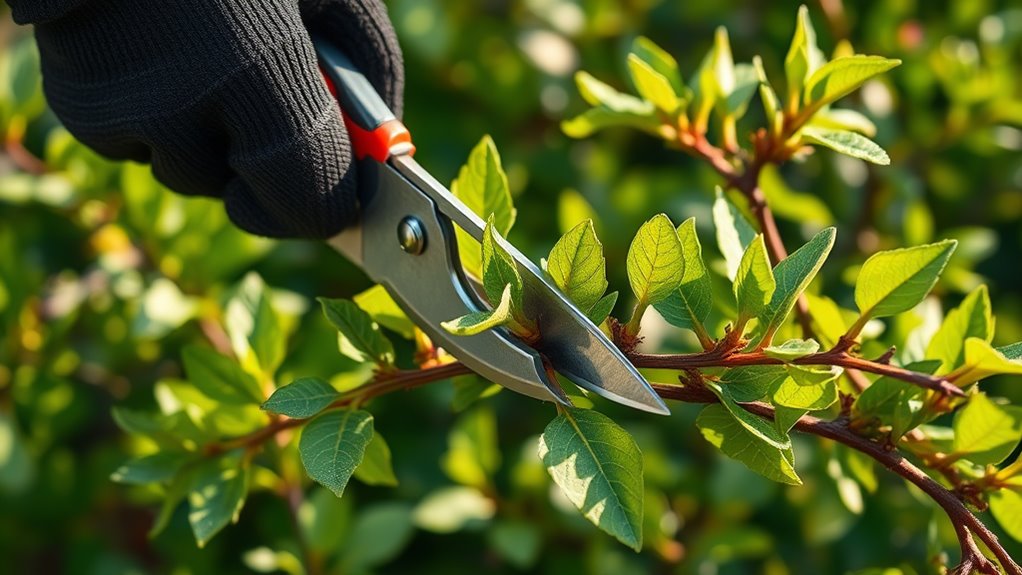The Ultimate Trick to Pruning Like a Pro (It’s Easier Than You Think)
You’ll prune like a pro by starting with the right tools—bypass pruners for live branches, loppers for thick stems, and a sharp pruning saw for larger limbs—while wearing gloves for safety. Time your cuts wisely: winter for dormant deciduous trees, right after blooming for spring shrubs, and summer for evergreens. Master basic methods like thinning for better air flow and heading for new growth, while avoiding over-pruning and making precise cuts. Explore these techniques to elevate your gardening game effortlessly.
Essential Pruning Tools
When you’re pruning plants, having the right tools guarantees clean cuts and healthy growth.
Essential tools include bypass pruners for live branches, anvil pruners for dead wood, loppers for thick stems, and a pruning saw for larger limbs.
Wear protective gloves for safety, and keep blades sharp to prevent damage. Proper tool maintenance is also crucial to ensure longevity and efficiency in your gardening tasks.
Choose quality tools to guarantee precise, effective pruning plants tasks.
Timing Your Pruning Sessions
Timing your pruning sessions correctly can make all the difference in promoting healthy growth and vibrant blooms.
It’s essential you align with your plant’s natural cycles to avoid stress and maximize vigor.
- Prune deciduous trees in winter during dormancy.
- Time spring-blooming shrubs right after flowering.
- Choose summer for evergreens’ light maintenance.
- Skip fall to prevent exposing plants to cold.
- Check weather first to pick ideal days.
Additionally, understanding the specific optimal times for pruning can help ensure your plants thrive throughout the seasons.
Fundamental Pruning Methods
To master fundamental pruning methods, you’ll start by learning basic pruning cuts that shape your plants precisely.
Next, select essential tools suited to your needs for clean, efficient work.
Finally, apply ideal timing techniques to maximize your plants’ health and growth. Additionally, understanding essential pruning techniques will help you achieve better results and maintain the longevity of your plants.
Basic Pruning Cuts
How can you master basic pruning cuts to keep your plants thriving?
These techniques shape growth and promote health effectively.
- Perform thinning cuts to remove entire branches, opening up space for light and air.
- Execute heading cuts to shorten stems at a bud, encouraging new growth.
- Try pinching to snip tips on young plants, fostering denser foliage.
- Use renewal cuts to prune back old wood, revitalizing shrubs.
- Make sure each cut is smooth and angled to aid quick healing.
Essential Tools Selection
Once you’ve mastered basic pruning cuts, you’ll select the right tools to execute them safely and efficiently.
For small branches, choose sharp bypass pruners for precise cuts.
Loppers handle medium-sized limbs with ease, while a pruning saw tackles thicker ones.
Prioritize ergonomic designs with non-slip grips to reduce strain, and guarantee blades are rust-resistant and easy to sharpen for clean, disease-preventing results.
Optimal Timing Techniques
When should you prune your plants for the best results?
Timing boosts health and minimizes stress, so align it with growth cycles.
- Prune dormant trees in late winter for easy healing.
- Cut back spring bloomers right after flowering.
- Avoid summer heat to prevent damage.
- Time evergreens for early spring growth spurts.
- Check local weather to dodge frost or drought.
Pruning Techniques for Various Plants
Now that you’ve mastered the fundamentals, you’ll apply tree pruning methods to promote healthy growth and structural integrity in your trees.
When working with shrubs, use cutting techniques that shape them precisely while encouraging vigorous blooming.
To maximize the benefits of your pruning efforts, remember to incorporate pruning and deadheading techniques that help rejuvenate your plants and extend their blooming season.
Let’s explore these approaches so you can tailor your pruning to each plant’s needs.
Tree Pruning Methods
Tree pruning methods vary by plant type, so you’ll select techniques based on factors like growth habits and health needs.
For trees, focus on precise cuts that support growth and safety.
- Thin crowns to boost light and air flow, enhancing overall vigor.
- Raise canopies by removing lower branches for clearance and visibility.
- Reduce tree size carefully to manage height without stressing the plant.
- Use pollarding to control shape on fast-growing species.
- Eliminate deadwood to minimize risks and encourage new growth.
Shrub Cutting Techniques
Shrubs demand tailored pruning to foster vigorous growth and shape, so you’ll start by evaluating the plant’s type and goals, like enhancing blooms or controlling spread.
For flowering shrubs, prune right after blooming to encourage next season’s flowers; for evergreens, thin out crowded branches annually.
Use sharp, clean tools to make clean cuts at a 45-degree angle, preventing disease and promoting quick healing.
Avoiding Common Pruning Errors
Even though pruning seems straightforward, many gardeners still make avoidable mistakes that can harm plants.
To keep your efforts effective, avoid these common errors:
- Don’t prune during active growth; it stresses the plant unnecessarily.
- Avoid over-pruning; never remove more than a third of the foliage.
- Use sharp, clean tools; dull ones cause damaging tears.
- Cut at the right angle; always above a bud for proper healing.
- Ignore natural shapes at your peril; enhance, don’t distort them.
Additionally, understanding the right timing is crucial as proper pruning timing significantly influences plant health and recovery.
Maintaining Plants After Pruning
Once you’ve pruned your plants, focus on watering them deeply but infrequently to aid recovery and prevent stress.
Monitor for pests or diseases regularly, as cuts can invite issues.
Mulch around bases to retain moisture and regulate soil temperature.
Avoid fertilizing immediately; wait a few weeks to let wounds heal.
Prune during cooler times to minimize shock, ensuring vibrant regrowth.

